React.js and React Native are both very popular technologies in the field of application building. Having similar names, they possess absolutely different features. In our blog post, we will dwell on the benefits that they can bring to you from a business perspective. Read on to discover the key differences between these technologies, the positive sides and limitations of using Reactjs and React Native, and discover the features that make them both truly unique.
What Is React.js?
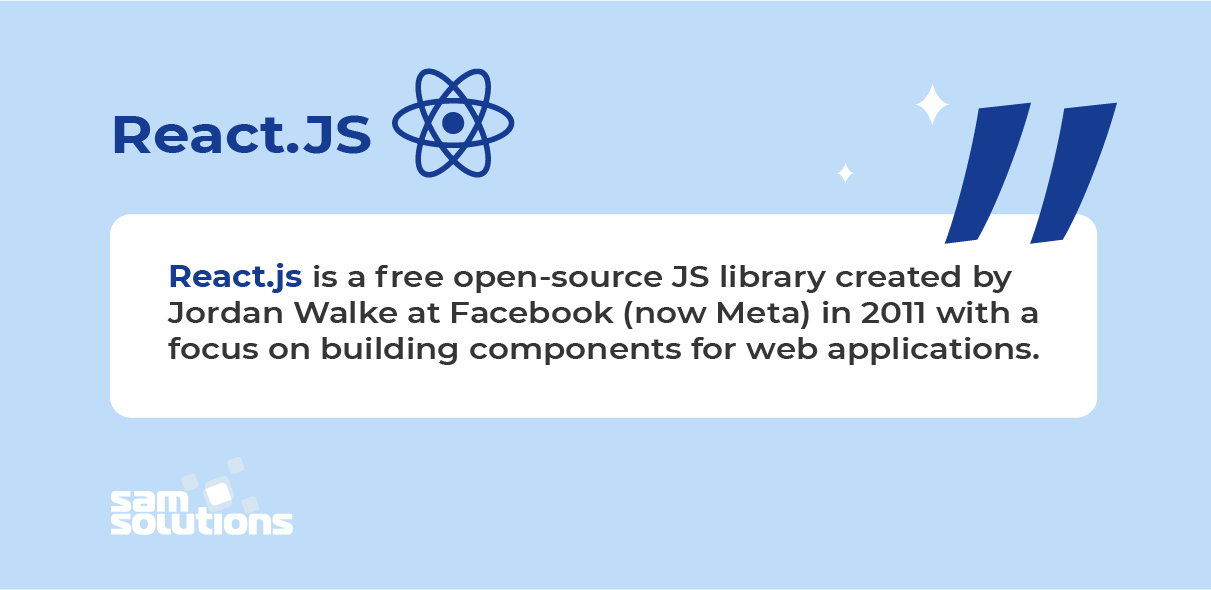
Reactjs is a free open-source JS library that the IT specialists use to create or render hierarchical UI components. As well-liked widespread JS library in use today, Reactjs is in demand among start-ups, medium-sized companies and big enterprises that mostly use it to build single-page apps (SPAs) and mobile apps. Due to the robust UI features of React js, it is especially useful for the creation of user interfaces for web and mobile applications.
The Reactjs JavaScript library is particularly aimed at building the view layers of web and mobile apps. With reusable components, it helps coders to produce more powerful structured apps. The advantages of Reactjs include speed, efficiency, suitability for component-oriented user interfaces, high flexibility, an active community of users, and its ability to create large-scale complex apps.
What Is React Native?
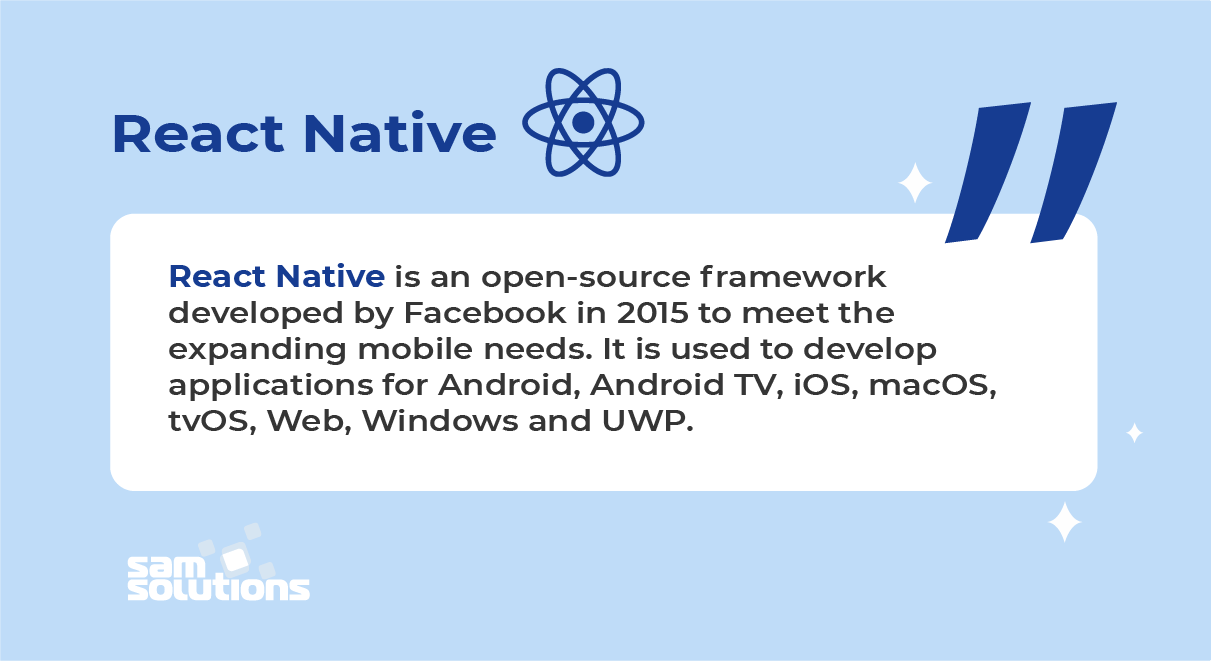
React Native is an open-source UI software framework. It is used for the creation of native apps with the help of JS language. It carries out the compiling of the native app components. The React DOM base abstraction is the base abstraction of Reactjs, and in the case of React Native, – a base abstraction of React Native. This means that, regardless of their very similar syntactical and procedural characteristics, their components are different.
React Native can use the same code between a variety of OS such as Android, iOS, Windows, etc. Other significant benefits of it are the native look and feel, capability to reuse identical coding on different platforms, live reload, focus on UI, cost-efficiency, foreign plugins and a large community of users.
Business Benefits of Using React.js
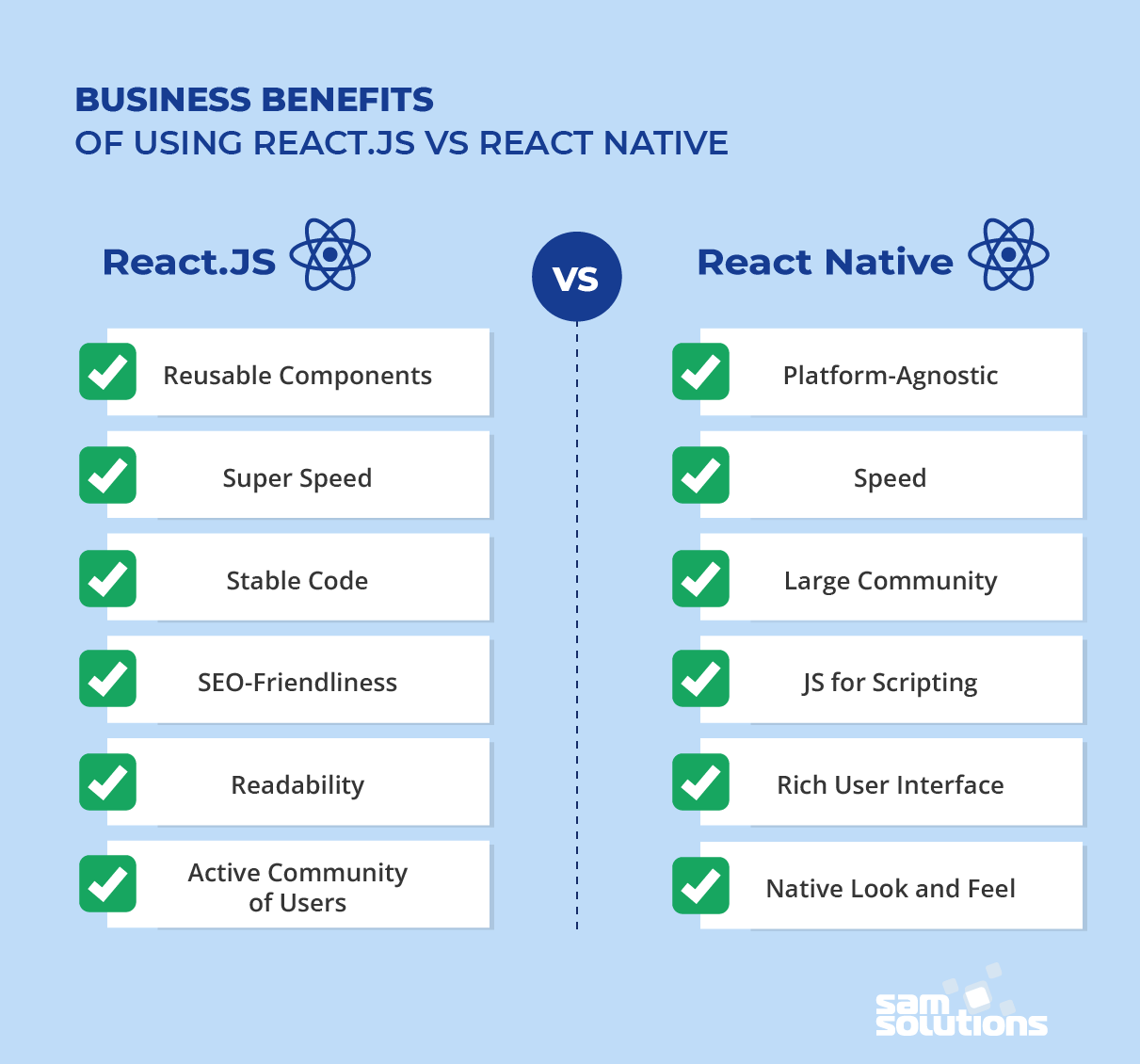
Reusable Components
Reactjs developers can reuse components, so they do not have to create new code for the similar app components, and this helps to make the work in Reactjs quicker. Furthermore, Reactjs is more efficient and, when separate parts of the application have been edited, this doesn’t influence other parts. This way, many errors in Reactjs are prevented early in the game, which saves time for testing.
Super Speed
Reactjs implements JS to write HTML, which leads to quicker performance of the web application and doesn’t require upgrading the DOM repeatedly.
Stable Code
Any adjustments performed on small Reactjs components do not affect the whole state. This means that when programmers introduce an adjustment to a small part, the greater part remains unaltered. As a consequence, the code can boast a high level of stability.
SaM Solutions’ talented React team is available to support you in any aspect of your React-based web or mobile development project.
SEO-Friendliness
With Reactjs, pages are rendered more quickly, and are better optimized to get more traffic to the website.
Readability
Reactjs code is not difficult to understand due to its modest number of one-of-a-kind concepts.
Active Community of Users
Reactjs boasts a rich community of loyal adherents, who cooperate to improve educational materials and implement the library’s potential more efficiently.
Business Benefits of React Native
Platform-Agnostic
It allows specialists to create apps for various platforms based on the coding specific to the platform you are working on.
Speed
Due to valuable features such as Hot Reload and improved developer experience in React Native, specialists can carry out reloading and do not have to intervene in the system manually.
Large Community
The active community of users consists of enthusiastic developers all over the globe who are always happy to help each other out and find solutions to new problems.
JS for Scripting
JS is truly great for scripting. Known for its simplicity, it’s not difficult to learn and master.
Rich User Interface
With rich instruments, programmers can provide a great user experience for their clients.
Native Look and Feel
Due to the robust features of this framework, developers can create apps with a truly native look and feel.
React.js vs React Native – Key Differences
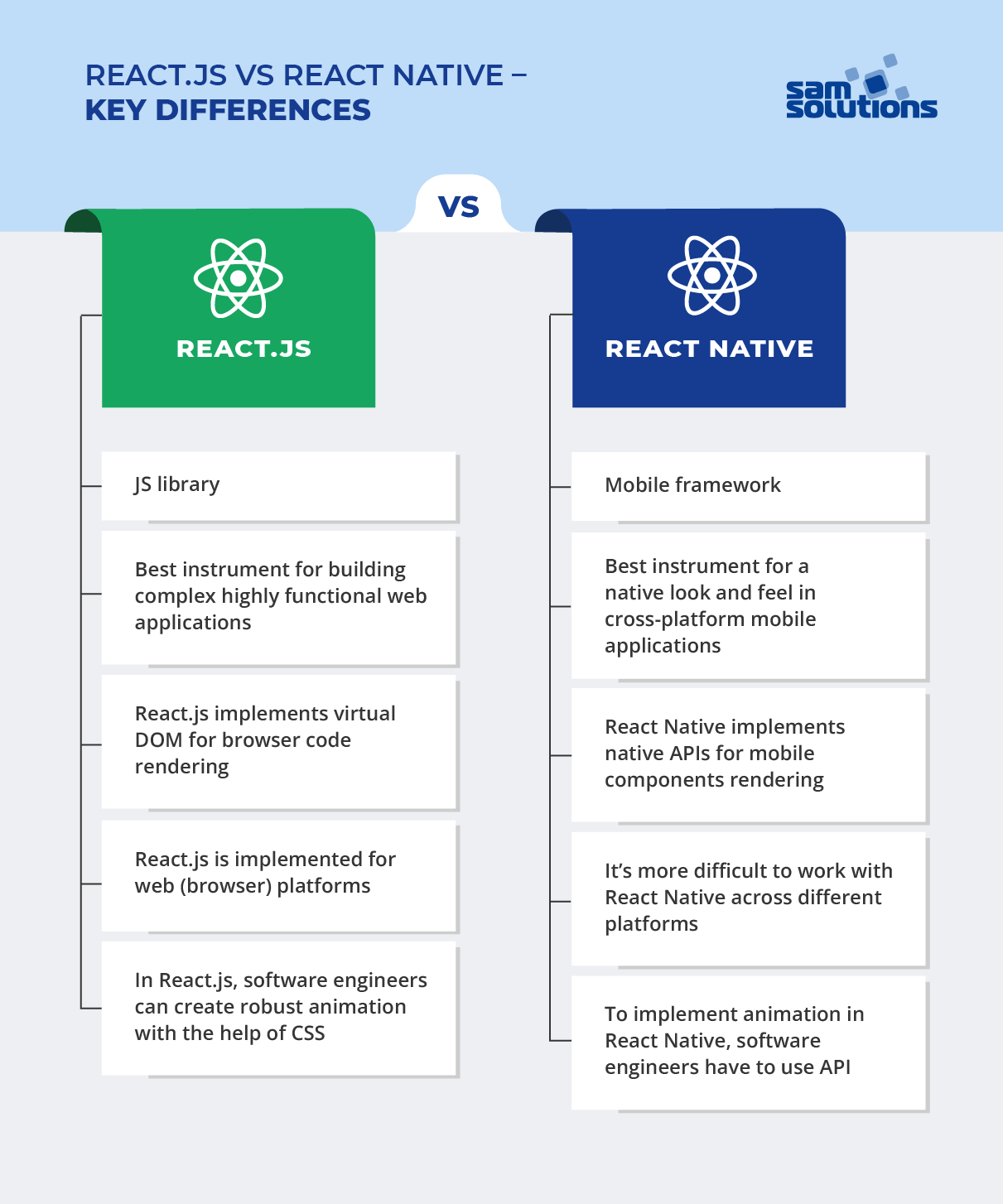
The following characteristics make React.js and React Native different:
- First and foremost, React.js is a JS library and React Native is a mobile framework. React Native is therefore based on Reactjs.
- Secondly, Reactjs is the best instrument for building complex highly functional applications, and React Native is aimed at adding native look and feel to mobile apps.
- Reactjs implements virtual DOM for browser code rendering; in React Native, native APIs are used .
- Reactjs is implemented for web (browser) platforms. It is challenging to work with React Native on various platforms.
- In React js technology, IT specialists can create robust animation based on CSS. In React Native, they use API.
React.js vs React Native – Comparing Individual Features which Make Both Unique in Their League
What Precisely Is React.js?
Reactjs is a JS library that is able to support rendering on both the client side and the server side. Furthermore, software developers can utilize this to produce UIs to be used in mobile apps and websites. Below, we will consider the advantages of Reactjs.
What Are the Advantages of React.js?
Lightning-Fast Speed
It offers the opportunity to develop web apps extremely fast thanks to the help of the document object model (DOM). Working in Reactjs is quicker – while a software engineer writes coding as if all the pages are rendered at each change, in reality only the components that underwent changes in Reactjs are rendered. That is why Reactjs is often preferred over other options for website and mobile web app development.
Component-Oriented Architecture
With this kind of architecture, it is possible to reuse components and save plenty of time.
Programmers can take constituent parts of a large UI and then convert them subsequently into an independent self-sufficient subsystem.
Boosted Search Engine Optimization
Reactjs can render the server side as well, so it can upgrade your marketing endeavors and drive more new visitors to your website. When Google crawlers visit such enhanced websites with rendered imaging and content, it will be easier for them to index and cache the content.
This approach in Reactjs improves your work on search engine optimization of your website. When Google bots index the content on the server side, the page loading time becomes quicker as well. The pages are quickly visible, and end users would receive top-notch UI.
Rich Tool Kit
Specialists all over the globe using Reactjs enjoy an elaborate system of instruments, libraries, IDEs, plug-ins, web browsers, etc., which can enhance the work of a developer tremendously and take the team effort to an entirely new level.
Reactjs users are blessed to be part of a huge community of developers, who have created a massive ecosystem of tools, component libraries, IDEs, extensions for code editors, web browsers, and more.
With so many third-party tools and add-ons available, Reactjs software developers can work with a fresh perspective towards innovative and effective app building, which ensures efficiency regarding time, human and monetary resources. Empowered by an active user community, Reactjs is among the leading technologies in the mobile web app world.
What Is React Native?
React Native is a multi-platform framework based on Reactjs for mobile app development. It can carry out compiling to native application elements, enable programmers to create cross-platform apps.
What Are the Advantages of React Native for Companies?
Platform-Particular
React Native can detect the platforms it runs on, and adapt the code accordingly.
Easier Programming
Interestingly, frontend web developers who possess the knowledge of JS, API and UIs can learn how to use React Native and then build an app using React Native as well. React Native can be learned and subsequently used almost effortlessly. Moreover, coders can utilize their knowledge of Reactjs for React Native development.
Quick Work
Thanks to Hot Reloading, React Native programmers are able to reload mobile apps in auto mode. This option is ultra time-saving and will substantially speed up your React Native project.
Built-in Libraries
React Native has various libraries inbuilt by default, with the aim of improved user interface development. React Native will also facilitate a time-efficient approach to software development, as you will not have to create them from scratch, allowing you to concentrate on your work more effectively.
Reactjs vs React Native – The Drawbacks and Limitations
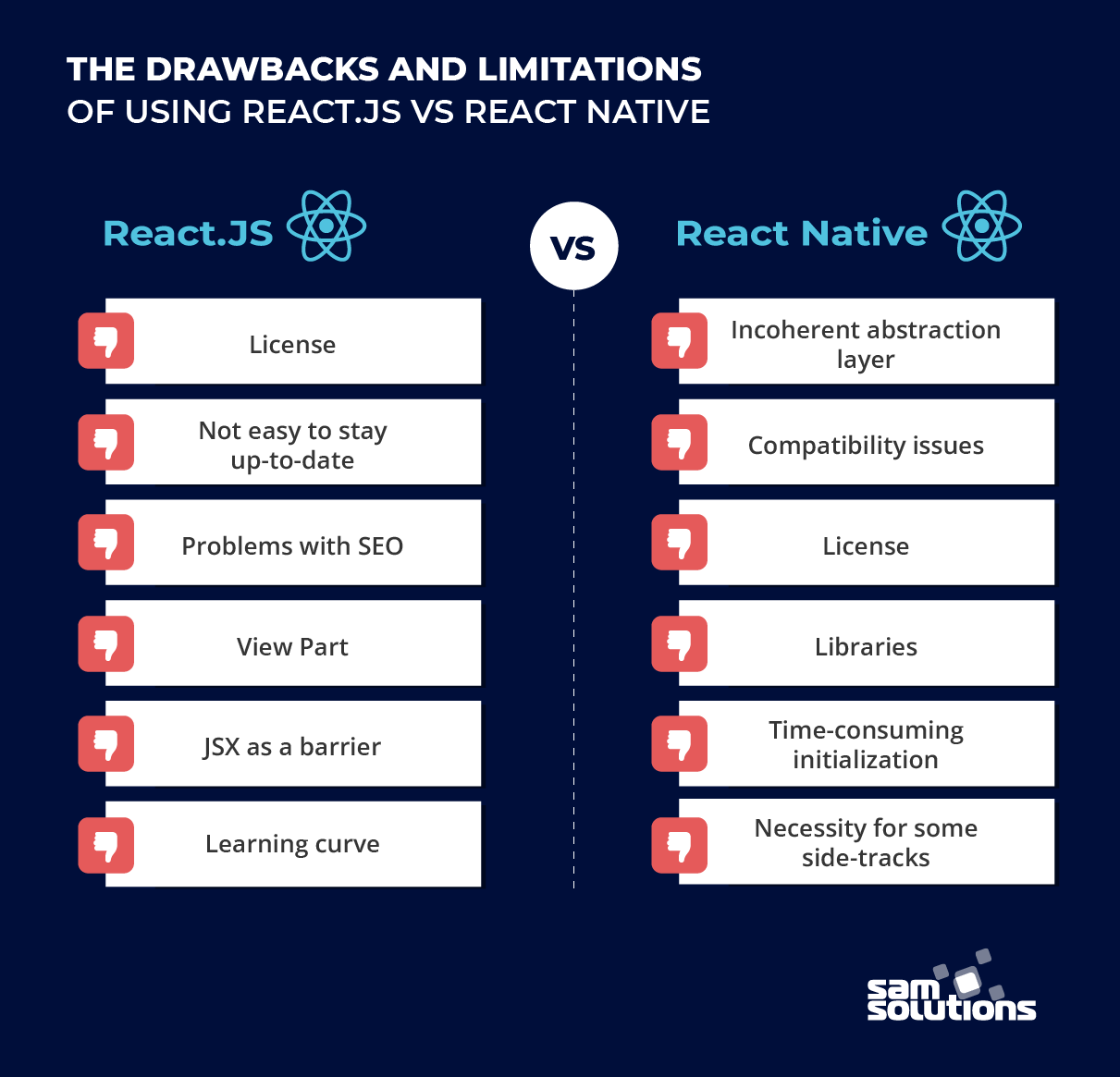
Reactjs Drawbacks
- License. Meta has power over React Native. Subsequently, when problems with licensing arise, it will take time to solve them.
- Not easy to stay up-to-date. The large community of software engineers introduce new adjustments and updates regularly, so Reactjs developers need to keep up with all the innovations to make sure their apps remain secure and do not become outdated.
- Problems with SEO. Certain search engine optimization hurdles may arise, as Google sometimes has issues with indexation of websites that have undergone rendering on the client side.
- View Part. As Reactjs can cover only user interface layers, developers need to find other ways to obtain complete toolsets for their projects.
- JSX as an obstacle. This add-on lets JS and HTML mix. Although it offers a number of advantages, software engineers often grumble at its intricacy.
- Learning curve. As it’s not a full-featured framework, it requires in-depth knowledge of numerous web technologies: JavaScript, HTML, CSS, Web APIs, etc.
React Native Drawbacks
- Incoherent abstraction layer. Even though it gives developers a lot of freedom, React Native has some issues, including the absence of enforcement of rules and parameters such as those in Java and Swift. So, clashes of logic can happen.
- Compatibility issues. Although it is widely implemented by large IT companies, developers still may encounter bugs and glitches. For that reason, novice coders who don’t have a complete grasp of this technology sometimes don’t spend enough time solving these issues.
- License. Meta has full control over React Native. As a result, when there are issues with the license and patents in React Native, they will not be solved quickly.
- Libraries. When developers need more robust functionality, the libraries that React Native offers may not be enough. For this purpose, software engineers often prefer other options.
- Time-consuming initialization. Because of the JS thread, it can be time-consuming for a gadget to carry out the initialization process in React Native.
- Necessity for some side-tracks. When there are no definite functionalities in React Native, software engineers can create a native module (for example, in Java), or resort to the help of native developers. This can result in more monetary and time investments in React Native, which can significantly increase the cost of the project.
Reach a wider audience by delivering your software to multiple devices with the assistance of SaM Solutions’ React Native developers.
Conclusion
Based on the information in our blog post, we hope you now have a better grasp of the differences between Reactjs and React Native and can make a more informed decision regarding which one is better for your project. Both Reactjs and React Native have numerous valuable features. So, which one is better for you?
That decision should be based on what exactly you need. Reactjs is the perfect tool for the creation of high-performing user interfaces with great responsiveness and dynamics, and React Native is aimed at making your mobile applications look native. Reactjs forms the core of React Native, which includes all of React’s basic syntactical features.
To make a final decision, it’s best to consult an expert. If you are interested in our tailored advice, our specialists at SaM Solutions would be glad to help you.



















 The Latest 15 Information Technology Trends in 2024
The Latest 15 Information Technology Trends in 2024 Top 10 Embedded Software Development Tools
Top 10 Embedded Software Development Tools IaaS vs. PaaS vs. SaaS: What’s the Difference?
IaaS vs. PaaS vs. SaaS: What’s the Difference? 10 Examples of Predictive Analytics
10 Examples of Predictive Analytics
![Web App Development Cost in 2025 [Key Price Factors]](https://www.sam-solutions.com/blog/wp-content/uploads/fly-images/31797/Web-App-Development-Cost-cover@2x-370x238.webp)











 Web App Development Cost in 2025 [Key Price Factors]
Web App Development Cost in 2025 [Key Price Factors] 13 Best React Development Tools in 2025
13 Best React Development Tools in 2025 Top 10 Mobile App Development Trends 2025
Top 10 Mobile App Development Trends 2025 Top IoT Industry Trends in 2025
Top IoT Industry Trends in 2025 Java Web App Security: Everything You Need to Know
Java Web App Security: Everything You Need to Know
React Native is a fast and easy way to build mobile applications using JavaScript. You can build complex apps quickly and easily with React Native.
My favorite is React Native. I have chosen it for its platform-independent nature, high development speed, large active community of users and rich UI.
I suppose the best way to find out which technology is better for you is to compare their advantages and disadvantages. This was succinctly covered in the article, so thank you.
It might be best to learn how to use both. I’ve been using React.js for years, which helped me learn React Native. They’re both quite useful in my work.
I don’t think one needs to choose between these two technologies, as each one is different and offers a unique set of technical features for different purposes.
For the project I’m working on, I’m using React.js, because it is a good instrument which gives me the opportunity to create a highly responsive dynamic interface.
I adore React.js, as it is ultra fast and offers reusable components. Other characteristics, such as readability and stability, make it extremely attractive as well.
Really enjoyed reading your article. I learned a lot from it. Especially valuable for me was to discover the business benefits of both technologies, as now I see more clearly which one is more beneficial for my enterprise.